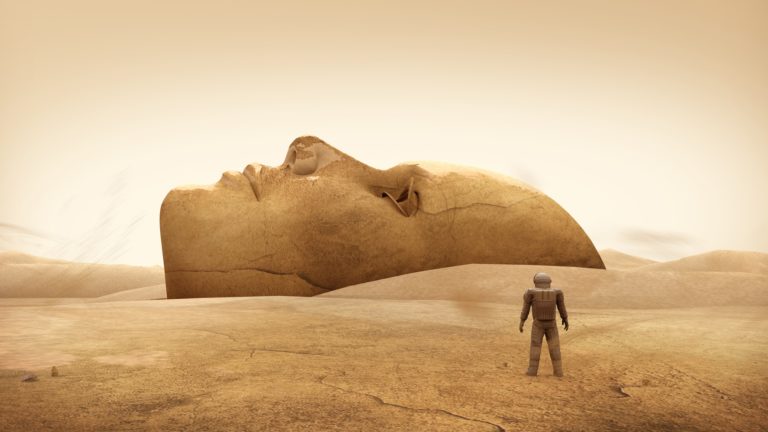Do These 7 Strange Features Show Life on Mars?

Over the past several decades, there have been numerous features uncovered that seem to show evidence of intelligent life that either inhabited or visited other planets in our solar system. This plethora of evidence has been a point of contention between ufologists and NASA, most notably the face on Mars’ Cydonia region.
Some of it can be easily brushed off as simply the product of shadows, lighting, or a little trick our brains play on us called pareidolia, which makes us see faces and familiar objects in the mundane. But could there actually be something behind this very convincing recurrence of inexplicable faces and structures, pointing toward an advanced civilization? With the discovery of flowing water on Mars, the answer seems like it might be yes.
1. The Face on Mars
The most commonly known and probably the most distinct of the unexplained features can be seen in images of the face on Mars in its Cydonia region. This face was originally found by two NASA contractors named, Vincent DiPietro and Gregory Molenaar. The two found images of the face taken by NASA’s Viking satellites which became a source of study and debate that continues today. The face appears to be wearing a helmet or headdress and further analysis seems to show teeth as well as the presence of eyes in the sockets. The face is quite large stretching almost two miles in length and just over one mile in width. And despite skeptics’ view that our ability to see a face is simply a play of shadows, multiple images and lighting angles have shown that the face is symmetrical. Other such faces of similar size and likeness were found and imaged in an area of Mars referred to as the Utopia region.
The face on Mars’ coordinates are: 40.74813 N 9.70136 W
Below are images of the face on Mars:

2. The Pyramids at Cydonia
What makes the face at Cydonia and its location so intriguing is that there are also several pyramids there. One can see these pyramidal shapes which appear to be grouped together and almost too distinct to be naturally occurring. Some believe that the layout of the pyramids as well as other features, such as a spiraled mound and buttress walls, point to the organized layout of a city. In addition, one feature known as the “D&M” pyramid, is distinctly five-sided and much larger than any pyramid on Earth.


The “D&M” Pyramid source: www.enterprisemission.com/sheep.htm
3. The Crowned Face
The Crowned Face, also referred to as the King’s Face is 11 miles wide and located in the Libya Montes region of Mars. The image shows a face with much greater detail than the face at Cydonia with distinct features and what appears to be a crown. Some have interpreted the right half of the visage to be the profile of a female face looking to the left, while others see layered faces. Since the face is not shadowed to the extent that the Cydonia face is, it is harder to dismiss as pareidolia.

Source: thecydoniainstitute.proboards.com/thread/43/crown-face
4. The Sumerian Face
This imagery from NASA appears to show a rock face that bears a striking resemblance to statues of ancient Sumerian gods. This picture compares the rock face to a statue of Nabu, the Sumerian God of literacy and wisdom. Could this be evidence that the Anunnaki once visited an ancient civilization on the red planet?

Source: cnet.com/news/ufo-fanatics-spot-ancient-god-on-mars/
5. Rock Face Buried in Sand
This particular face, found in an outcropping of rocks, also bears some semblance to depictions of Sumerian gods. This rock face is found half-buried in the sand and looks to be distinctly carved.

Source: projectblueworld.com
6. Egyptian-like Statues
Images taken by a NASA rover in the Victoria Crater purport to show what look like statues embedded in a cliff. These statues bear an uncanny resemblance to Egyptian sarcophagi or statues of the Annunaki of Ancient Sumer.


Source: disclose.tv/news/has_nasa_discovered_an_annunaki_statue_on_mars
7. The Meridiani Face
Although it is on of the least distinct faces of all of those spotted on Mars, the face on the Meridiani Planum is thought to be another source of evidence of possible intelligent creation. Two eyes that are closed or squinting can be seen with a large nose and protruding cheekbones. The Meridiani plain is located near Mars’ equator. What do you make of it?
Asgardia: The Space Nation Now Accepting Citizenship Applications

Elon Musk is trying to get to Mars, Japan wants to build a space elevator, and now a Russian billionaire wants to start a nation in low-earth orbit. Named after the Norse city in the sky, Asgardia dreams to be a utopian nation floating around Earth, where science and technology can flourish without being inhibited by the mundane goings-on down below.
Igor Ashurbeyli, an aerospace engineer from Azerbaijan, proposed the creation of Asgardia and quickly gained a following. Now, with nearly 200,000 “citizens,” he’s hoping to be accepted by the U.N. as a recognized nation in the world – the 173rd largest at time of writing.
Recently, Ashurbeyli partnered with NASA to successfully launch a satellite into orbit called the Asgardia-1. But the satellite was a small step in accomplishing the lofty goal of building habitable platforms for Asgardians at some point in the future.
Asgardia-1 is roughly the size of a loaf of bread, containing half a terabyte of pictures, names, the Asgardian constitution, and a coat of arms. It will orbit for about a year, before falling back to Earth and burning up in the atmosphere.






































